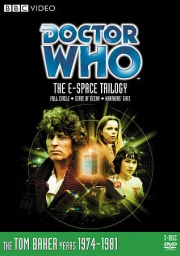The E-Space Trilogy
- Sci-Fi
- 1980
- Buy the DVD
Reviewed by Ross Ruediger
()
ike 1970 before it, 1980 was a year of transformation for “Doctor Who.” Incoming producer John Nathan-Turner and his new script editor, Christopher H. Bidmead, were keen to institute a number of changes to a series that had become increasingly stale, as well as difficult to take seriously. JN-T wanted to give the show a massive visual overhaul (including a new title sequence accompanied by a fresh arrangement of the theme tune), while Bidmead was keen to whip up some serious, hardcore sci-fi. Together, they reinvented the show for the new decade, and their success as a team is most obvious within the confines of this three-part storyline, which saw the Doctor (Tom Baker), Romana (Lalla Ward), and K-9 (voiced by John Leeson) trapped in another universe known as E-Space. Along the way, they pick up the mathematical boy genius Adric (Matthew Waterhouse), and by the end of the trilogy, the TARDIS crew goes through some pretty big changes as well.
The box set kicks off with the story “Full Circle.” While attempting to return home to Gallifrey, the TARDIS accidentally passes through something called a Charged Vacuum Emboitment and ends up on the marshy planet Alzarius, located in a smaller universe known as E-Space (as opposed to our own universe, N-Space). There, the Doctor and Romana find the Starliner, a ship stranded on the planet, seemingly for generations. Inside lives a small civilization whose long range plan involves getting the Starliner working again so they can return to the planet Terradon, from where they originally came. But outside the ship is Mistfall, which the Terradonians fear, as it contains something fierce, primal, and – most importantly - unknown.
“Full Circle” is great “Doctor Who.” (I once knew a guy who swore it affected him for life after seeing it as a kid.) It’s well written and acted, loaded with mood, and features wonderful monsters in the form of the Marshmen, who clearly seem inspired by the Creature from the Black Lagoon. It was the one instance in the classic series run that a story was written by a fan. Andrew Smith – at the time still a teenager – had, over the years, been submitting story ideas through several script editors’ tenures, and finally Bidmead saw something in his work that warranted the green light. Good thing, too, as “Full Circle” was one of the smartest premises the series had seen in several years, and the reveals in Episode Four bring together the story’s various strands effortlessly. The tale also introduces the character of Adric, who has suffered the wrath of many a “Who” fan ever since he was introduced all those years ago. Thing is, Adric quite simply isn’t that bad, especially in his first season, and I’d argue that he never even came close to ruining any of the stories in which he appeared. Admittedly, he became somewhat less interesting when playing against Peter Davison, but the dynamic Waterhouse shares with Tom Baker works pretty well. Could the character ultimately have been drawn better? Sure he could have, but the same can be said about countless companions that traveled in the classic series TARDIS. In any case, if Adric is all it takes to ruin these stories for you, it’d be best to stop reading now.
The middle part of the trilogy, “State of Decay,” is its most traditional, uncomplicated outing, which should come as no surprise since it’s written by Terrance Dicks, “Who’s” script editor from the early seventies. (In fact, it isn’t a tough stretch to envision the tale as a cracking, latter-era Jon Pertwee installment.) Materializing on an unnamed planet, the Time Lord duo, along with the stowaway Adric, discover a Middle Ages-type society of peasants lorded over by the inhabitants of a nearby gothic castle. The Three Who Rule are Zargo, Camilla and Aukon, centuries-old astronauts turned vampires dedicated to the resurrection of the Great Vampire, a giant beast which sleeps beneath the castle, waiting to resurrect. What follows is a straightforward yarn, filled with all the standard vampire clichés you know and love, as well as various “Who” spins thrown into the mix to keep the proceedings from feeling completely derivative. The whole thing is just about as much fun as it sounds, and never once does it try to be anything other than exactly what it is. It’s somewhat amazing that it took “Doctor Who” nearly 20 years to do a vampire story, but when they finally got around to it, the results were a wonderfully campy and spooky success.
Wrapping things up with an artsy crescendo is ‘Warriors’ Gate,” which for the open-minded viewer will be the highlight of this set. It is quite simply unlike any other “Doctor Who” story created before it, and unlike any that’s been unveiled since. How unique is it? Well, some of its ideas are rooted in the plays “Waiting for Godot” and “Rosencrantz and Guildenstern are Dead,” if that gives you clue as to what you can expect. The TARDIS arrives in a stark, white void on the edge of E-Space. Nearby is another ship, also trying to escape the tiny universe. Onboard is a group of slave traders who deal in harnessing the power of the Tharils, a lion-like race of time-sensitives. It’s a surreal race against time to escape the void, as well as a morality play about which group represents the greater evil – the human slave traders, or the captive Tharils, who once treated their human servants as poorly as they’re treated now.
Written by Stephen Gallagher (creator of such recent fare as “Crusoe” and “Eleventh Hour”), “Warriors’ Gate” is one of the most underrated and least talked about stories in the show’s history. Perhaps that is because it’s more difficult to discuss than it is to experience; very little of what’s written here will prepare you for the feel and tone of the proceedings. This story of time and space folding inwards and outwards begs repeated viewings just to begin to understand what it’s all about, as well as to appreciate what director Paul Joyce brought to the table for his sole “Who” outing. Joyce had big ideas for “Doctor Who” – some of them too ambitious, and the production was fraught with problems from the word go; it’s remarkable that it turned out to be such a solid tale. It is also the final story for both Romana and K-9, and as such it marks the end of an era for “Doctor Who,” paving the way for the Davison years right around the corner. (I really didn’t say much about K-9 in this review, but it must be mentioned that he’s put through all manner of abuse in these stories – especially in “Full Circle,” which clearly demonstrates the amount of contempt the production team must have had for the tin dog by this point.)
When I think of “The E-Space Trilogy,” one word leaps to mind: atmosphere. These three stories overflow with it. Tom Baker was getting nearer and nearer to his journey’s end, and these are the stories where not only the viewer first begins feeling it, but it shows on Baker’s face and in his manner as well. John Nathan-Turner would go on to produce the show for the following eight seasons, right up until its cancellation. Much of JN-T’s tenure has been met with harsh criticism, but it’s clear through stories like these that he was capable of achieving greatness with the concept, and that, at least in the beginning, he took the show very seriously. All that said, Chris Bidmead deserves just as much credit, and listening to him speak in the various documentaries and commentaries reveals that he was a guy with a big vision, and he fought hard to protect it. It’s a huge shame he left the series after only one season, as who knows where he might have taken the show had he stayed onboard. He did stick around to pen Davison’s freshman outing, “Castrovalva,” and then a few years later he returned once more with the classic “Frontios,” but that’s a story for another day, and another review.
Bottom line: This is the best classic “Who” release so far this year, and it’s must-have material for old school fans. The three stories are not available separately, but given the price of the set, it’s basically a “buy two, get one free” scenario – a real bargain by classic “Who” DVD standards.
Special Features: Not much to see here, folks. Nah, just kidding! There’s plenty to sift through, unless you’re looking to hear from Tom Baker, who is noticeably absent from all the supplemental material this time around. Once you’ve accepted that, you can move on to the commentary tracks, which are a given for each story, which feature Matthew Waterhouse, Lalla Ward, John Leeson, Chris Bidmead, Andrew Smith, Peter Moffat, Terrance Dicks, Paul Joyce and effects designer Mat Irvine. Each story gets it own informative “making of” doc (the “Warriors’ Gate” entry is wonderfully tell-all), as well as numerous featurettes; “State of Decay” vamps out in a big way with its various mini-docs, and a major highlight on the “Warriors’” disc is called “Lalla’s Wardrobe,” which covers every outfit Romana II wore during her time on the series. Isolated music scores for each story, and a few bits of previously unseen deleted material for your perusal, alongside the usual trails and continuities, photo galleries, production notes options and DVD-ROM Radio Times listings round out the set.
You can follow us on Twitter and Facebook for content updates. Also, sign up for our email list for weekly updates and check us out on Google+ as well.













